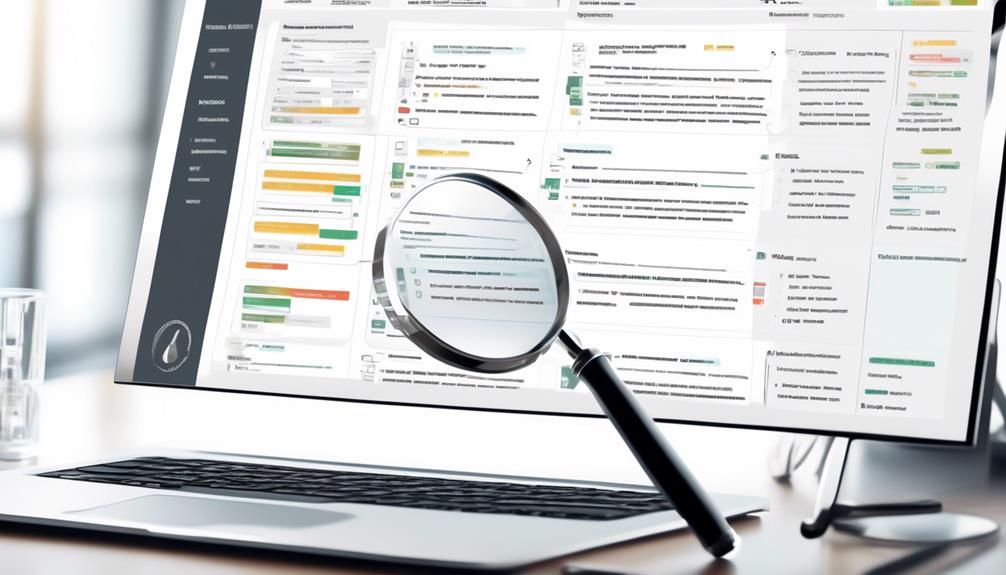We are all familiar with the challenges that software bugs can present, leading to a substantial global impact totaling a remarkable $1.1 trillion annually. But now, let’s shift our focus to Software Quality Assurance (SQA). What is its significance?
Well, it's not just about finding and fixing bugs. SQA encompasses a comprehensive approach to ensuring that the software meets quality standards at every stage of its development.
But what exactly does this process entail, and why is it so crucial in today's tech-driven world?
Join me as we explore the intricacies of SQA and unravel its significance in delivering reliable, high-quality software solutions.
Key Takeaways
- Software Quality Assurance (SQA) ensures software meets quality standards at every stage of its life cycle
- SQA goes beyond error identification and includes creating an SQA plan
- SQA aims to prevent defects from occurring and reduces the risk of errors and defects
- SQA upholds quality standards, saves time and costs, and enhances software stability and competitiveness
Definition of Software Quality Assurance
In software development, the term 'Software Quality Assurance' refers to the meticulous process of ensuring that the software meets predetermined quality standards at every stage of its life cycle. Software Quality Assurance (SQA) is an integral part of the software development process, working in parallel to ensure that the product meets established quality specifications. It involves a comprehensive approach to quality, aiming to catch and rectify any potential shortcomings before the software is released to the public.
SQA goes beyond mere error identification, encompassing a broad range of quality aspects. It includes creating an SQA plan, setting checkpoints for regular quality inspections, deploying software engineering techniques to ensure high-quality specifications, conducting formal technical reviews, and utilizing a multi-testing strategy. The primary goal of SQA isn't only to detect defects but also to prevent them from occurring in the first place.
Moreover, SQA extends its focus beyond software testing to ensure the software's portability, usability, reusability, correctness, and maintainability. This detailed approach to quality assurance is vital in the software development process, as it ultimately impacts the reliability and success of the final product.
Key Components of Software Quality Assurance

Key components of Software Quality Assurance encompass:
- Applying a comprehensive quality management approach to ensure adherence to established standards throughout the software development process.
- Formal technical reviews play a crucial role in evaluating the design and quality of the software, identifying and addressing any issues that may arise.
- A multi-testing strategy is essential, utilizing various testing approaches to comprehensively test the software and ensure its quality.
- Effective software engineering technology is a critical component, employing advanced techniques to achieve high-quality specifications and meet standards for software quality attributes.
- The implementation of a robust measurement and reporting mechanism is vital, providing a means to track and report on the quality of the software throughout the development process.
Each of these components plays a significant role in the Software Quality Assurance Plan, ensuring that quality is a fundamental aspect of all software development processes, activities, and management within a project. This ultimately leads to high-quality software products.
Importance of Software Quality Assurance
Building on the foundation of key components in Software Quality Assurance, the importance of SQA in ensuring high-quality software products can't be overstated. SQA plays a pivotal role in upholding quality standards and ensuring that software meets customer expectations. By implementing rigorous software testing and a defect management approach, SQA significantly reduces the risk of errors and defects, ultimately saving time and costs while enhancing the stability and competitiveness of the software product.
Throughout the Development Life Cycle (SDLC), SQA is crucial for maintaining quality management, continuously monitoring, and improving the software. It not only enhances the efficiency and reliability of the software but also contributes to its maintainability, usability, and portability. Moreover, SQA is essential for safeguarding the reputation and credibility of a business, as it ensures security, compliance, and customer satisfaction.
The responsibilities of SQA encompass various critical aspects, including adherence to quality standards, comprehensive testing, and effective defect management. By fulfilling these responsibilities, SQA significantly contributes to the overall success of software development, thereby emphasizing its indispensable importance in the software industry.
Implementation of Software Quality Assurance

Implementing Software Quality Assurance requires a meticulous approach to ensure that established quality specifications are consistently met throughout the software development life cycle. It involves setting up standards and procedures for quality assurance and quality control.
This implementation process requires careful planning, as it encompasses various activities such as formal technical reviews, multi-testing strategies, and the use of advanced software engineering techniques. The implementation of SQA also involves creating an SQA plan that outlines the checkpoints for regular quality inspection and identifies the responsibilities of each team member in maintaining quality standards.
Additionally, it requires a systematic approach to integrate quality assurance and quality control into the daily work of software development. This includes utilizing tools and methodologies that enable continuous monitoring and improvement of the software quality.
Difference Between Quality Assurance and Testing
Quality assurance and testing serve distinct purposes in the software development process, each with its own specific focus and objectives.
Quality assurance (QA) primarily concentrates on ensuring that software meets established quality specifications, encompassing ongoing processes that run parallel to software development to check for quality issues in each phase. It aims to catch product shortcomings before the public sees them, covering activities like creating an SQA plan, setting checkpoints for regular quality inspection, and conducting formal technical reviews to evaluate design and quality.
On the other hand, testing is a specific phase focused on identifying and reporting bugs. Its primary goal is to find errors, and it may or may not involve addressing and solving identified errors. While QA encompasses a multi-testing strategy for comprehensive testing, testing itself is focused on finding errors in the software.
Frequently Asked Questions
What Does Software Quality Assurance Consist Of?
Software Quality Assurance consists of several key components.
First, there is the creation of a plan, which outlines the overall approach to quality assurance for a software project. This plan may include details on inspection checkpoints, engineering techniques, and formal reviews that will be used throughout the development process.
The second component is the implementation of this plan. This involves carrying out the inspection checkpoints, deploying the engineering techniques, conducting the formal reviews, and ensuring that all steps are followed according to the plan.
The third component is the multi-testing strategy. This strategy involves testing the software from various angles and perspectives to ensure that it meets the required quality standards.
SQA also covers various aspects of software quality, including portability, usability, reusability, correctness, and maintainability. These factors are important in ensuring that the software is not only functional but also reliable and easy to use.
Overall, SQA aims to catch any shortcomings in the software before it is released to the public. By resolving errors and ensuring that the software meets the necessary quality standards, SQA helps to improve the overall user experience and satisfaction.
To achieve these goals, a quality management approach is necessary. This approach ensures that all aspects of SQA are properly managed and executed. It also includes formal technical reviews, which provide a structured and systematic way to assess the software's quality.
In addition, effective software engineering technology is key to successful SQA. This technology includes tools and techniques that aid in the development, testing, and evaluation of software products.
Measurement and reporting mechanisms are also important components of SQA. These mechanisms allow for the monitoring and tracking of the software's quality throughout the development process. They provide valuable insights into the effectiveness of the SQA efforts and help to identify areas for improvement.
What Is the Role of a Quality Assurance Software?
The role of Quality Assurance Software is to ensure the software meets established quality specifications throughout the development process.
It works parallel to software development, checking for quality issues in each phase and aims to catch product shortcomings before public release.
Our team creates an SQA plan, sets checkpoints for regular quality inspection, deploys software engineering techniques, conducts formal technical reviews, and employs a multi-testing strategy to uphold quality standards.
What Do You Mean by Quality Assurance?
Quality assurance ensures that products meet established quality standards throughout the development process. It goes beyond simple error detection, aiming to solve issues and prevent them from reaching the public.
An interesting statistic is that SQA can reduce production costs by up to 50% and prevent up to 90% of potential issues.
This meticulous process involves creating a solid SQA plan, regular quality inspections, and comprehensive testing to ensure high-quality software that meets client expectations.
What Is an Example of Quality Assurance in Software?
An example of quality assurance in software is ensuring the usability, portability, correctness, maintainability, and reusability of the software product.
We achieve this by:
- Creating an SQA plan
- Setting checkpoints for regular quality inspection
- Deploying software engineering techniques
- Conducting formal technical reviews
- Utilizing a multi-testing strategy
Our approach involves:
- Auditing
- Reviewing
- Code inspection
- Design inspection
- Simulation
These techniques are used to ensure software quality.
Conclusion
In the world of software development, Software Quality Assurance is like the meticulous gardener who carefully tends to each plant, ensuring that they grow strong and vibrant.
It involves constant monitoring, inspection, and problem-solving to ensure that the final product meets the highest quality standards.
Just as a master chef carefully tastes and adjusts their dish, SQA ensures that software is flawless and ready to delight its users.
Rick, our Software Quality Assurance Writer, is the creative force behind many of our insightful articles and course materials. His unique background in software development, fused with his natural flair for writing, allows him to convey complex QA concepts in a way that is both informative and captivating. Rick is committed to keeping abreast of the latest trends and advancements in software testing, ensuring that our content remains not just relevant, but at the forefront of the field. His significant contributions are instrumental in helping us fulfill our mission to deliver premier QA education.










